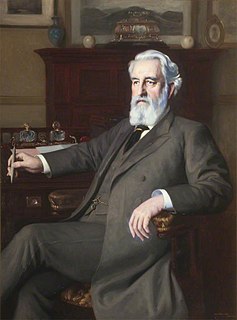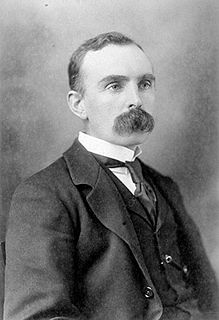
The Dean Cemetery is a historically important Victorian cemetery north of the Dean Village, west of Edinburgh city centre, in Scotland. It lies between Queensferry Road and the Water of Leith, bounded on its east side by Dean Path and on its west by the Dean Gallery. A 20th-century extension lies detached from the main cemetery to the north of Ravelston Terrace. The main cemetery is accessible through the main gate on its east side, through a "grace and favour" access door from the grounds of Dean Gallery and from Ravelston Terrace. The modern extension is only accessible at the junction of Dean Path and Queensferry Road.

Sir Frank Watson Dyson, KBE, FRS, FRSE was an English astronomer and Astronomer Royal who is remembered today largely for introducing time signals ("pips") from Greenwich, England, and for the role he played in proving Einstein's theory of general relativity.

The Royal Society of Edinburgh is Scotland's national academy of science and letters. It is a registered charity, operating on a wholly independent and non-party-political basis and providing public benefit throughout Scotland. It was established in 1783. As of 2017, it has more than 1,660 Fellows.

The Royal Meteorological Society is a long-established institution that promotes academic and public engagement in weather and climate science. Fellows of the Society must possess relevant qualifications, but Associate Fellows can be lay enthusiasts. Its Quarterly Journal is one of the world's leading sources of original research in the atmospheric sciences.
Prof Ralph Allan Sampson FRS FRSE LLD was a British astronomer.
Prof William Michael Herbert Greaves FRS FREng FRSE was a British astronomer. He is most noted for his work on stellar spectrophotometry.

Sir Thomas Henry Holland was a British geologist who worked in India with the Geological Survey of India, serving as its director from 1903 to 1910. He later worked as an educational administrator at Edinburgh University.

Sir William Watson Cheyne, 1st Baronet, was a Scottish surgeon and bacteriologist, who pioneered the use of antiseptic surgical methods in the United Kingdom.
Dr Thomas Southwell FRSE FZS (1879–1962) was a 20th century British zoologist and parasitologist.
Dr James Stuart Thomson FRSE FLS (1868–1932) was a 19th/20th century Scottish zoologist. He was an expert on the tortoise.








